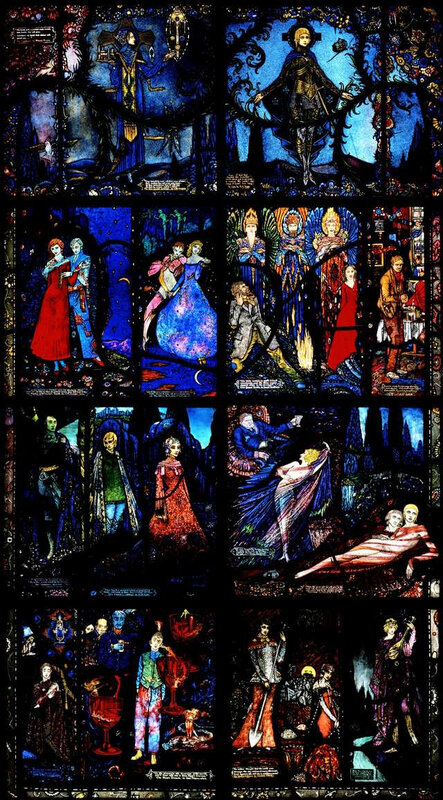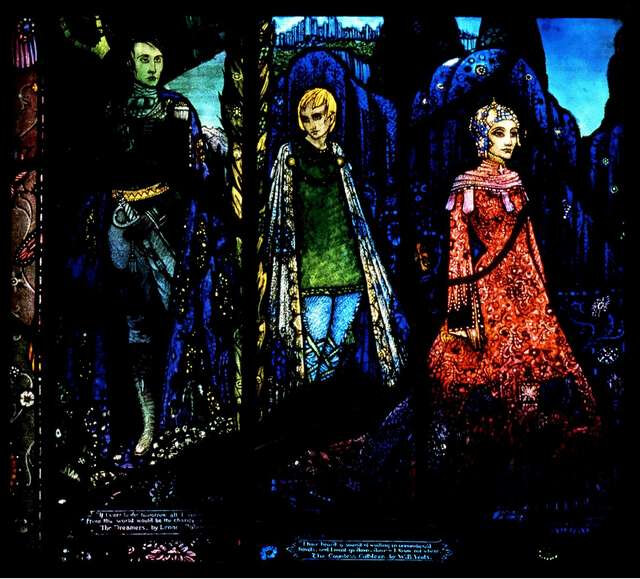Geneva Window, the Scandalous Stained-Glass Masterpiece by Harry Clarke
It was June 1925 when representatives of the Irish Department of Industry and Commerce approached Harry Clarke with the idea of designing a stained glass window for the International Labor Court in Geneva as a gift of the newly established Irish state. Clarke was already an established illustrator by then and one of the most famous designers of stained glass in the world.
The initial idea came from Miss Brighid Stafford, but this offer was not the only one coming from Ireland. They also suggested a carpet, a painting, and a work in Irish marble. Thanks to the fact Germany already donated stained glass to the same organization, Clarke’s window was not the favorite, yet the idea was eventually accepted by authorities in Geneva.
The window should present scenes from the most well-known pieces of Irish literature. Clarke and William Butler Yeats suggested 15 authors and work to be included and the list was confirmed in 1927 by the government. The project took Clarke and his studio for about two years. It was about to be finished when his health worsen so seriously he had to visit a sanatorium in Switzerland. His best men in the studio were left with detailed instructions to finish the project.
His health worsen so much the project was delayed for a full year but at least he managed to finish the last corrections by himself. He framed the window in with 71,5 inches by 40 inches dimensions hoping it will be installed during next weeks. It never came to Geneva.
During all the phases there were already numerous challenges during the work, mostly thanks to innovative yet challenging Clarke’s technique. His usage of acids and lead led to extremely attractive effects caused by colors and light. Presented characters were glowing, sometimes looking like surrounded by flames, like they are not of this world. Considering different phantasy, legendary, and religious scenes were involved, the aim of the artist was obvious.
(This part (panel 6) for instance, cracked at final firing. It was edited later and the scene didn't enter the final design.)
On the other side glass treated under such intense conditions became very fragile and cracks were expected in any phase, especially in later ones. Addition of numerous decorative elements (Henry Clarke was still a member od Art Nouveau movement) and quotes from literary works with inscriptions made the panels even more sensitive to all kinds of stress.
Working with highly hazardous materials which eventually caused health issues and death of Clarke (and several other stained art artists from his era) was another undesirable side effect. At first, his eyes were losing sight, then he felt of the bike, getting many injuries, then he was diagnosed tuberculosis. He died just being 41 years old.
But none of these problems caused so serious obstacle as the political attitude towards the scenes depicted. Fifteen scenes from the same number of works and authors were selected and confirmed by Minister Patrick McGilligan. It took politicians several years to authorize the sketches done by the artist who was understandably excited with a possibility to exhibit his work in such a prestigious location. Then, when they finally settled with the project, they wanted it as soon as possible.
Clarke did his best, but he was already loaded with other work and replied he needs about half a year to finish it. When the Geneva window was finally done, the criticism on the depicted scenes (remember, there were fifteen of them) started:
- Synge’s The Playboy of the Western World already had to be altered in the sketch phase.
- O’Sullivan’s The Others was also met with criticism as it may cause misunderstandings and offense.
- President Cosgrave also suggested the panel presenting Mr Gilhooley by Liam O’Flaherty to be replaced because it looked too provocative.
- According to Gordon Campbell (as the Secretary of the Department of Industry and Commerce he was already involved with the project from the very beginning right to the approval stages) even the selection of censored Joyce on the panel number 15 was not acceptable.
This means all Clarke’s hard work was heavily criticized despite all efforts he made before and during the process of planning, making constricting and editing the Geneva Window. He tried to save the project with a suggestion of several alternatives which should be presented in the meeting but such a meeting never happened. He died before the window was accepted and when it was, it wasn’t sent to Switzerland but installed in Merrion Street in one of the Government Buildings.
Clarke’s widow Margaret, an established painter herself bought it back next year (for the same price as received) but it was not immediately returned. The first crack in the window appeared in 1932 and the second in 1933. After that, the window was returned to Clarke’s studios to be repaired and it stayed in the family for several decades.
After Margaret’s death, the Geneva window was lent to Dublin’s Municipal Gallery of Modern Art where it was exhibited from 1963 to 1980. Then it was decided to be relocated - to the storage room. Harry Clarke’s sons took it back. In 1988 it was exhibited again, this time through the Fine Art Society in London when an art collector Mitchell Wolfson offered to buy it for his collection. The price was 100 hundred thousand British pounds.
This very special piece of art finally found a home at Wolfsonian Foundation at the University of Florida, Miami, where it’s permanently displayed.
Panel 1
The Wayfarer by Patrick Pearse
The beauty of the world hath made me sad
This beauty will pass,
Sometimes my heart hath shaken with great joy
(These verses were written on the eve of Pearse’s execution, what is represented with a black plate where the inscription is written, surrounded by flowers.)
The Story brought by Brigit (A Passion Play in Three Acts) by Lady Gregory
They bruised His brow with their crown of briars;
They mocked Him with every ugly thing;
He that could have shrivel them all with fire
He held His silence and He is a King
(The play was first performed at the Abbey Theatre in 1924.)
Panel 2
Saint Joan (A Chronicle Play in Six Scenes and an Epilogue) by George Bernard Shaw
O God that made this
beautiful earth,
When will it be ready
to receive thy Saints;
How long, O Lord, how long?
(The play was first published in 1921, right after the martyr and so-called Warrior Saint was canonized. She is presented with short hair-cut, surrounded by decorative flowers and leaves, waiting for execution, already slightly floating above the ground.)
Panel 3
The Playboy of the Western World by John Millington Synge
Well the heart’s a wonder; and I’m thinking there
won’t be our like again in Mayo, for gallant lovers, from this hour today
(The controversial theatre play was first published in 1907, the chosen scene is showing lovers in the moonlight just before the tragic incident.)
The Others by Seumas O’Sullivan
And now they pause in their dancing
And look with troubled eyes,
Earth’s straying children
With sudden memory wise
(The poem was published in Padraic Colum’s Anthology of Irish Verse in 1922, don’t miss the dancing elves above the lovers.)
Panel 4
The Demi-Gods by James Stephens
The dark curtain of night moved noiselessly,
and the three angels stepped nobly in the firelight
(The novel was published in 1914, the scene with three angels is from the second chapter of the first book.)
Juno and the Paycock by Sean O’Casey
Joxer’s song, Joxer’s song – give us
wan of your shut-eyed wans
(The play was staged in Dublin in 1924 for the first time, the depicted scene shows Captain Boyle asking Joxer to sing his favorite song.)
Panel 5
The Dreamers by Lennox Robinson
If I were to die tomorrow, all I would ask from the world
would be the charity of its silence
(We can see the figure of Robert Emmet in the last of this 3-act play from 1915 when he is saying he can’t leave Ireland.)
The Countess Cathleen by William Butler Yeats
I have heard a sound of wailing in unnumbered
hovels, and I must go down, down, I know not where
(The song from 1892 is telling the story about the title character who is willing to sell her soul for saving her residents from hunger. The influence of Ballets Russes is clearly visible in her blue, purple, and red outfit.)
Panel 6
Mr Gilhooley by Liam O’ Flaherty
She came towards him dancing, moving the folds of the veil
so that they unfolded slowly as she danced
(The sentence from the censored novel was published in Chapter XI in 1926 and is part of the scene where the main characters are both drunk and ’indecent’.)
Deirdre by George (AE) William Russell
I know the great gift we will give to the
Gael will be a memory to pity and sigh
over: and I shall be the Priestess of Tears
(The scene from the second act of the three-act drama, first performed in 1902 and published in 1907 presents the title character with her lover Naisi in the wood.)
Panel 7
A Cradle Song from Wild Earth by Padraic Colum
Mavourneen is going from me and from you,
Where Mary will fold him with mantle of blue
(The song was first published in 1907, Arnold Bax set it to music in 1922. Please note the Virgin Mary and Child protecting the worried mom and her baby.)
The Magic Glasses by George Fitzmaurice
It’s the pleasure and diversion of the world
You’ll hear and see in them magic glasses
(The scene from the play, first performed in 1913, focuses on the three magic red glasses, representing women.)
Panel 8
The Weaver’s Grave by Seamus O’Kelly
The widow thought that the world was
strange, the sky extraordinary, the man’s
head against the red sky a wonder, a poem
(The scene from a short story from 1919 presents a young widow with a gravedigger behind her. There is a silhouette of two more gravediggers as a contrast to the golden sun.)
On Music from Chamber Music by James Joyce
There’s music along the river
For love wanders there
Pale flowers on his mantle
Dark leaves on his hair’
(The mandolin player is a personification of the verse from 1907. This panel is signed with Harry Clarke Dublin 1930.)














/https%3A%2F%2Fstorage.canalblog.com%2F89%2F55%2F1589261%2F133585214_o.jpg)
/https%3A%2F%2Fstorage.canalblog.com%2F11%2F01%2F1589261%2F133001925_o.jpg)
/https%3A%2F%2Fstorage.canalblog.com%2F55%2F16%2F1589261%2F127513441_o.jpg)
/https%3A%2F%2Fstorage.canalblog.com%2F81%2F17%2F1589261%2F126599513_o.jpg)